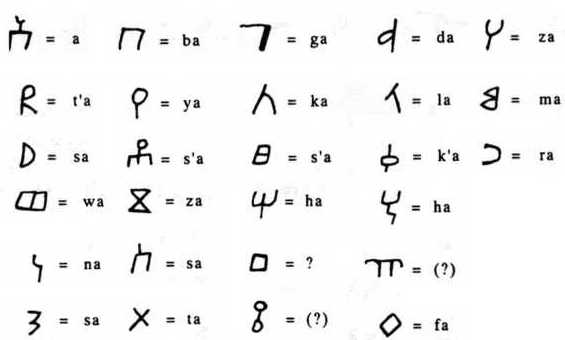Ge'ez
Ge’ez is to Ethiopia as Latin is to the west. Ge’ez, like Latin, was not used as a spoken language for a very long time. But like Latin, Ge’ez is the precursor of Ethiopia’s three major Semitic languages:
"In order to convey an idea of the relationship of Amharic, Tigrinya and Tigré towards each other and towards Ge’ez, we might enlist the helpful parallel of the Romance languages. If Ge’ez is compared to Latin, Tigrinya takes the place of Italian (both because it is most closely akin to the ‘parent’ tongue and also on account of its continuance in the original home). Tigré would then be likened to Spanish and Amharic to French.’’ (Edward Ullendorff qtd. in Buxton 31).
Amharic is the official language of Ethiopia and it is spoken most widely in the northwest and central part of the country. Tigrinya is mostly spoken in northern and northeastern Ethiopia. Tigré is spoken in the independent nation of Eritrea, formerly part of Ethiopia (Pankhurst 7-8).
The south Arabian immigrants brought with them the Sabean language into Ethiopia sometime early in the first millennium BCE, possibly by the Aguezat settlers (Doresse 23). By early in the next millennium, a distinctive Ethiopian version, influenced by the indigenous Cushitic peoples, was being used in stone inscriptions (Hetzron 242).


Before the fourth century, Ge’ez had not made use of vowels. But the usage of vowels was incorporated into Ge’ez when the Aksumites converted to Christianity, which occurred sometime in the fourth century. Pankhurst suggests that the reason that the alphabet was modified at the time could have been due to "the wish to make Biblical texts more intelligible to newly literate.” (25). The bible was translated into Ge’ez from Greek. Greek influence is also seen in the organization of the Ge’ez letters, which is very similar to Greek alphabet organization (Asher 1149).
Ge’ez ceased to be used as a spoken language most likely a short time before the tenth century CE. Nonetheless, it is being used today as the "liturgical language of the Ethiopian Orthodox Church, and was the only official written language of Ethiopia practically up to the end of the nineteenth century.” (Hetzron 242).